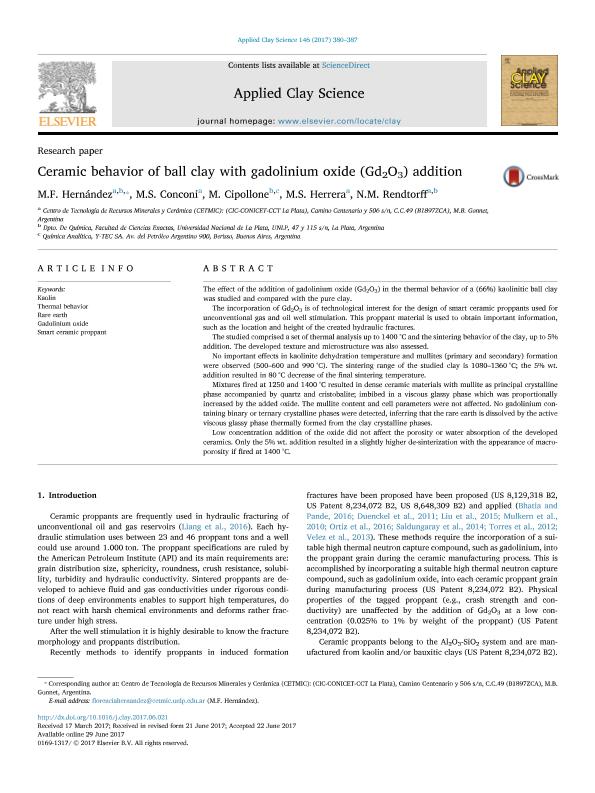Mostrar el registro sencillo del ítem
dc.contributor.author
Hernández, Maria Florencia

dc.contributor.author
Conconi, María Susana

dc.contributor.author
Cipollone, M.
dc.contributor.author
Herrera, Maria Silvia

dc.contributor.author
Rendtorff Birrer, Nicolás Maximiliano

dc.date.available
2018-06-18T20:24:24Z
dc.date.issued
2017-09
dc.identifier.citation
Hernández, Maria Florencia; Conconi, María Susana; Cipollone, M.; Herrera, Maria Silvia; Rendtorff Birrer, Nicolás Maximiliano; Ceramic behavior of ball clay with gadolinium oxide (Gd2O3) addition; Elsevier Science; Applied Clay Science; 146; 9-2017; 380-387
dc.identifier.issn
0169-1317
dc.identifier.uri
http://hdl.handle.net/11336/49130
dc.description.abstract
The effect of the addition of gadolinium oxide (Gd2O3) in the thermal behavior of a (66%) kaolinitic ball clay was studied and compared with the pure clay. The incorporation of Gd2O3 is of technological interest for the design of smart ceramic proppants used for unconventional gas and oil well stimulation. This proppant material is used to obtain important information, such as the location and height of the created hydraulic fractures. The studied comprised a set of thermal analysis up to 1400 °C and the sintering behavior of the clay, up to 5% addition. The developed texture and microstructure was also assessed. No important effects in kaolinite dehydration temperature and mullites (primary and secondary) formation were observed (500–600 and 990 °C). The sintering range of the studied clay is 1080–1360 °C; the 5% wt. addition resulted in 80 °C decrease of the final sintering temperature. Mixtures fired at 1250 and 1400 °C resulted in dense ceramic materials with mullite as principal crystalline phase accompanied by quartz and cristobalite; imbibed in a viscous glassy phase which was proportionally increased by the added oxide. The mullite content and cell parameters were not affected. No gadolinium containing binary or ternary crystalline phases were detected, inferring that the rare earth is dissolved by the active viscous glassy phase thermally formed from the clay crystalline phases. Low concentration addition of the oxide did not affect the porosity or water absorption of the developed ceramics. Only the 5% wt. addition resulted in a slightly higher de-sinterization with the appearance of macro-porosity if fired at 1400 °C.
dc.format
application/pdf
dc.language.iso
eng
dc.publisher
Elsevier Science

dc.rights
info:eu-repo/semantics/openAccess
dc.rights.uri
https://creativecommons.org/licenses/by-nc-nd/2.5/ar/
dc.subject
Gadolinium Oxide
dc.subject
Kaolin
dc.subject
Rare Earth
dc.subject
Smart Ceramic Proppant
dc.subject
Thermal Behavior
dc.subject.classification
Recubrimientos y Películas

dc.subject.classification
Ingeniería de los Materiales

dc.subject.classification
INGENIERÍAS Y TECNOLOGÍAS

dc.title
Ceramic behavior of ball clay with gadolinium oxide (Gd2O3) addition
dc.type
info:eu-repo/semantics/article
dc.type
info:ar-repo/semantics/artículo
dc.type
info:eu-repo/semantics/publishedVersion
dc.date.updated
2018-06-18T14:20:28Z
dc.journal.volume
146
dc.journal.pagination
380-387
dc.journal.pais
Países Bajos

dc.journal.ciudad
Amsterdam
dc.description.fil
Fil: Hernández, Maria Florencia. Provincia de Buenos Aires. Gobernación. Comisión de Investigaciones Científicas. Centro de Tecnología de Recursos Minerales y Cerámica. Consejo Nacional de Investigaciones Científicas y Técnicas. Centro Científico Tecnológico Conicet - La Plata. Centro de Tecnología de Recursos Minerales y Cerámica; Argentina
dc.description.fil
Fil: Conconi, María Susana. Provincia de Buenos Aires. Gobernación. Comisión de Investigaciones Científicas. Centro de Tecnología de Recursos Minerales y Cerámica. Consejo Nacional de Investigaciones Científicas y Técnicas. Centro Científico Tecnológico Conicet - La Plata. Centro de Tecnología de Recursos Minerales y Cerámica; Argentina
dc.description.fil
Fil: Cipollone, M.. Y-TEC; Argentina
dc.description.fil
Fil: Herrera, Maria Silvia. Provincia de Buenos Aires. Gobernación. Comisión de Investigaciones Científicas. Centro de Tecnología de Recursos Minerales y Cerámica. Consejo Nacional de Investigaciones Científicas y Técnicas. Centro Científico Tecnológico Conicet - La Plata. Centro de Tecnología de Recursos Minerales y Cerámica; Argentina
dc.description.fil
Fil: Rendtorff Birrer, Nicolás Maximiliano. Provincia de Buenos Aires. Gobernación. Comisión de Investigaciones Científicas. Centro de Tecnología de Recursos Minerales y Cerámica. Consejo Nacional de Investigaciones Científicas y Técnicas. Centro Científico Tecnológico Conicet - La Plata. Centro de Tecnología de Recursos Minerales y Cerámica; Argentina
dc.journal.title
Applied Clay Science

dc.relation.alternativeid
info:eu-repo/semantics/altIdentifier/doi/http://dx.doi.org/10.1016/j.clay.2017.06.021
dc.relation.alternativeid
info:eu-repo/semantics/altIdentifier/url/https://www.sciencedirect.com/science/article/pii/S0169131717302818
Archivos asociados
